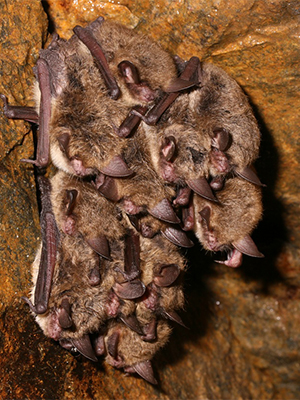

The northern long-eared bat was once a relatively common bat in the eastern U.S.

The Indiana Bat is an endangered species that has been on the decline throughout its Midwestern range due to habitat loss for many years, and is increasingly threatened by the exotic fungal disease called White-nose Syndrome (WNS). Two of Iowa’s bats species are listed on the federal Endangered Species Act and are therefore the focus of special monitoring and conservation in Iowa. That inconspicuous lifestyle is also the reason many Iowans don’t understand or appreciate bats or know the challenges their populations face. Many bats live alongside Iowans in every county, though they often go unnoticed because of their nocturnal lifestyle. During winter when insect prey are no longer available, bats disappear from sight, with some species retreating deep into caves or abandoned mine shafts to hibernate, some taking shelter in attics or barns, and others leaving the state entirely to spend the winter in warmer southern climates. Any tight space close to good insect food sources near forest edges, openings, or waterways, invites bats. Mothers raise their young in the foliage of trees, in or on buildings, around transportation infrastructure like bridges, in hollowed out trees, or in rock crevices. Iowa’s bats spend their summers in landscapes with trees generally near water, with some species preferring the interiors of forests and others prone to flying about city lights in search of food. Bats are thus an extremely important part of our ecosystems, helping control populations of problematic insects like beetles, including corn rootworm, and mosquitoes. All of these bat species are aerial insectivores, using their skilled echolocation to hone in on flying insects in forests, fields, and over water. Nine species of bats are found regularly in Iowa’s fields and forests.


 0 kommentar(er)
0 kommentar(er)
